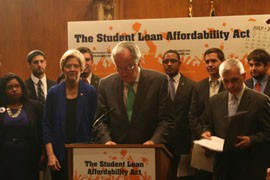Cronkite News has moved to a new home at cronkitenews.azpbs.org. Use this site to search archives from 2011 to May 2015. You can search the new site for current stories.
With clock ticking, Arizona students take college debt fight to Washington
WASHINGTON – Arizona State University sophomore Anisha Hindocha works hard to put herself through school without having to take out loans – so hard that it’s started to affect her health.
“I ended up with being in a hospital last semester,” said Hindocha, who has worked multiple jobs to pay the bills.
Despite the health scare, however, she said the jobs are worth it to avoid “paying ridiculous amounts of money” that come with school loans.
Hindocha was one of several Arizona students Thursday who were pushing Washington to change the formula for student loans before July 1, when the rate for Stafford loans is set to go from 3.4 percent to 6.8 percent.
The change would affect more than 7 million students and former students with loans, including about 450,000 in Arizona.
But Senate action on a plan to halt the loan increases stalled Thursday when senators failed to get the necessary votes to move forward on either a Democratic or a Republican bill. The Democrats would have kept the rate stable for another two years and paid for it by closing some tax loopholes, while the Republicans would have tied the loans to current low market rates.
The House has passed a bill similar to the Senate Republican measure, but President Obama has said it is not acceptable.
Meanwhile, students wait and wonder.
“We are less than four weeks away from July 1,” said Sen. Tom Harkin, D-Iowa, at a news conference Thursday shortly after the Senate stalemate. “As this deadline draws closer, students and their families need Congress to take action.”
Harkin, the chairman of the Senate Health, Education, Labor and Pensions Committee, was joined by several Democratic colleagues at the Capitol Hill conference and backed by a number of students, including Hindocha and fellow ASU student Katherine Richard.
Richard, a junior, said that costs are relatively low at a state school and that she has scholarships to help pay the bills. But it’s still a concern.
“Even if the school is paying for part of the tuition, that doesn’t cover the rest of that,” she said.
Back in Arizona, Shayna Stevens was also watching the debate closely.
The Northern Arizona University, who is majoring in secondary education, said she has a full-time job in the summer and a part-time job during the school year, but still has a lot of loans. Stevens estimates that she will have about $41,000 in debt when she graduates and starts looking for a job as a teacher.
In 2011, students in Arizona graduated with an average debt of $19,950, according to “Student Debt and the Class of 2011″ from the Institute for College Access and Success, a nonprofit organization.
In addition to the direct impact on students, high student loan debt could affect the nation’s economic recovery as a whole, said an official with the Arizona Public Interest Research Group.
“Despite the number of unemployed workers looking for jobs right now, the lack of an educated workforce remains a persistent problem in Arizona,” said Serena Unrein, a public interest advocate with ArizonaPIRG.
By 2020, she said, some estimates show that 64 percent of the jobs in the state will require a certificate or degree, but only 31 percent of Arizona’s population currently has one or the other.
“Congress should keep in mind that the ultimate goal of investing in students is to invest in our future economy,” Unrein said. “It is shortsighted to generate profits now while pushing students deeper into debt.”
- Cronkite News Service reporter Jonathan Reid contributed to this report.








